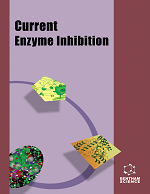- Home
- A-Z Publications
- Current Enzyme Inhibition
- Previous Issues
- Volume 14, Issue 1, 2018
Current Enzyme Inhibition - Volume 14, Issue 1, 2018
Volume 14, Issue 1, 2018
-
-
Recent Developments on Tyrosinase Inhibitors based on the Chalcone and Aurone Scaffolds
More LessAuthors: Ioanna Kostopoulou and Anastasia DetsiChalcones and aurones are natural products which belong to the flavonoid family and possess a variety of pharmacological and biological activities. Chalcones and, in a lesser extent, aurones, are especially versatile chemical scaffolds, therefore a large number of synthetic analogues have been prepared and studied for their tyrosinase inhibitory activity. This report aims to briefly present all the studies about the tyrosinase inhibit Read More
-
-
-
In vitro Evaluation of Biological Effects of Metallic Compounds with Quinolines
More LessIntroduction: Modified quinolines have been used as metal chelators, and they have drawn the attention of researchers due to the possible biological approaches with a broad scope of application. This study aims to evaluate the in vitro biological effects of seven quinolinic compounds in RAW macrophage culture, blood cells and in Candida albicans fungus. Methods: Cell viability and proliferation of macrophages were eval Read More
-
-
-
Pyrazolyl Benzamides: Synthesis, Characterization and Potent Biological Activity, Part-2
More LessAuthors: Akula Ganesh, Darna Bikshapathi and Ravindra KulkarniBackground: A range of biological activities including anti-inflammatory, antiangiogenic, antitubercular and kinase inhibitory activity have been reported for pyrazole derivatives. Serious medicinal chemistry approaches for the development of effective antibacterial agents have resulted in only few new compounds with the lack of activity against a wide range of microbes. In continuation with our quest for developing anti-inf Read More
-
-
-
17β-N-arylcarbamoylandrost-4-en-3-one Derivatives as Inhibitors of the Enzymes 3α-Hydroxysteroid Dehydrogenase and 5α-Reductase
More LessBackground: The involvement of 3α-hydroxysteroid dehydrogenase (3α-HSD AKR1C2) in the processes of liver metastasis and prostate cancer has been previously reported. Increased 5α- reductase 1 (5α-R1) activity in prostate cancer has also been reported. Therefore, overexpression of 3α-HSD and 5α-R1 could be related to drug resistance and disease progression of liver and prostate tumors. Aim: The aim of this study was Read More
-
-
-
Predicted Mechanism of Antiasthmatic Drugs in Depression Based on Their Interaction with SERT and 5-HT1A Receptors
More LessBackground: Depression associated with asthma enhances asthma-related morbidity and mortality. While antidepressants (AD) are prescribed in depression, β2-adrenergic agonists (BAA) and xanthines are used in asthma. Asthma treatment side effects include depression and suicidal ideation. Objective: Here, we identified a possible mechanism of BAA and xanthines to induce depressant or antidepressant responses b Read More
-
-
-
Molecular Modeling Interaction Between Enzyme Diabetes Type 2 Dipeptidyl- Peptidase (DPP-4) and Main Compound of Cinnamon
More LessAuthors: Bouchentouf Sali, Ghalem Said, Missoum Noureddine and Allali HocineBackground: Nowadays molecular modeling is widely used in different areas of scientific research. Especially in medical and pharmaceutical research molecular modeling allows saving time and money in conception of new drugs by comprehension of interaction between disease's enzymes and inhibitors for probable formation of stable complex. Cinnamon as famous plant and culinary spice is highly recommended i Read More
-
-
-
Angiotensin I Converting Enzyme-inhibiting Peptides Purified from Elastase-degraded Elastin Prepared from Pig Aorta
More LessAuthors: Iori Maeda, Shohei Kai, Suguru Taniguchi, Asako Inoue, Hujun Li, Hitoshi Kesamaru and Takeru NoseBackground: Many peptides are produced from food proteins during the manufacturing of various functional foods; unexpected and valuable physiological activities are frequently identified in such released peptides. Elastin, which normally exists as an insoluble elastic fiber, is being used as a new health food material in accordance with the progress in solubilization techniques for elastin. Objective: To evaluate the usefulness Read More
-
-
-
Vigna unguiculata Trypsin Inhibitor: A Protein with Versatile Biological Applications
More LessBackground: Trypsin Inhibitors are one of the most promising and investigated subject for their role in pharmacognostical and pharmacological studies. Aim: The paper describes purification and characterization of trypsin inhibitor obtained from blackeyed cowpea (Vigna unguiculata). Methods: The purification procedure of Vigna unguiculata trypsin inhibitor (VUTI) includes homogenization followed by ammonium sulph Read More
-
Volumes & issues
-
Volume 20 (2024)
-
Volume 19 (2023)
-
Volume 18 (2022)
-
Volume 17 (2021)
-
Volume 16 (2020)
-
Volume 15 (2019)
-
Volume 14 (2018)
-
Volume 13 (2017)
-
Volume 12 (2016)
-
Volume 11 (2015)
-
Volume 10 (2014)
-
Volume 9 (2013)
-
Volume 8 (2012)
-
Volume 7 (2011)
-
Volume 6 (2010)
-
Volume 5 (2009)
-
Volume 4 (2008)
-
Volume 3 (2007)
-
Volume 2 (2006)
-
Volume 1 (2005)
Most Read This Month
Article
content/journals/cei
Journal
10
5
false
en


